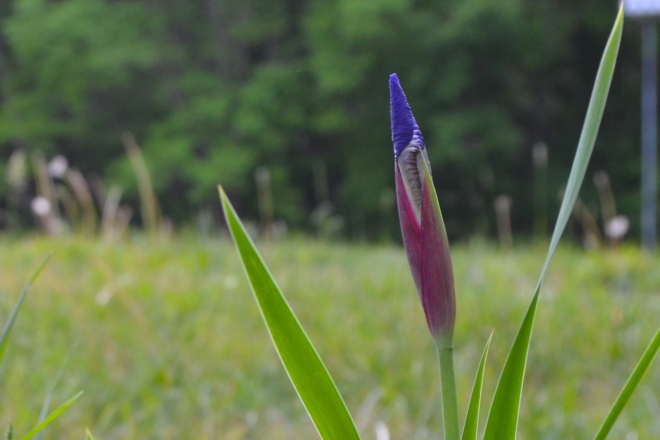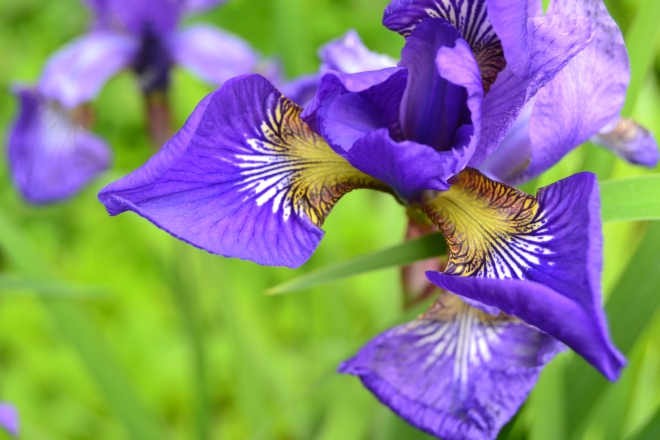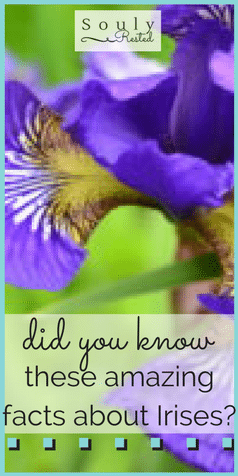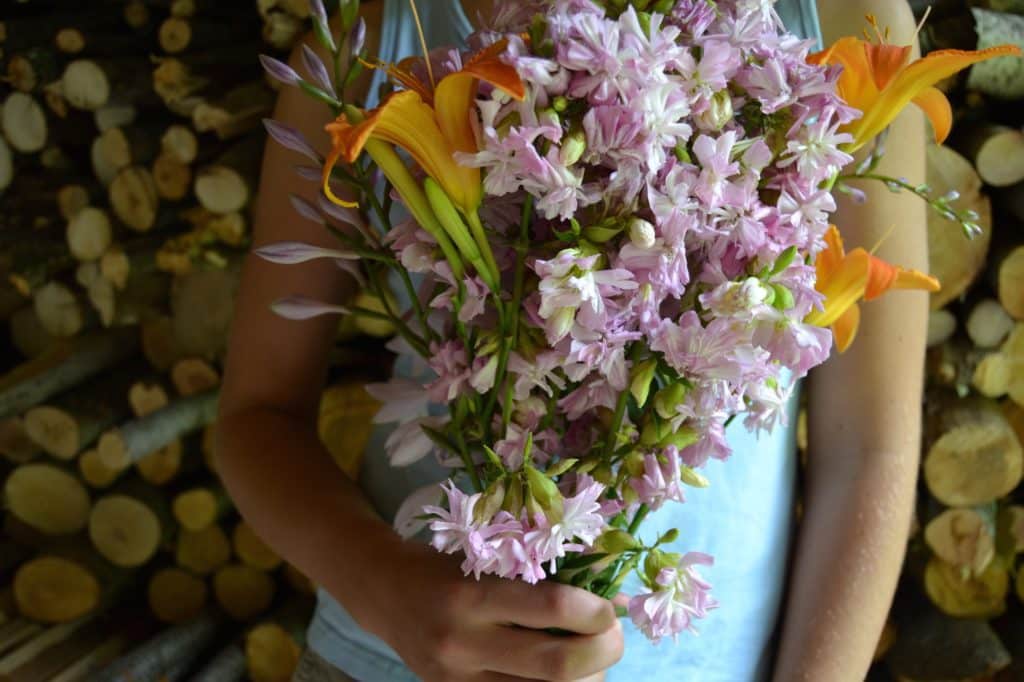Last Updated on June 20, 2024 by Michelle
I just recently learned some pretty interesting facts about the Iris flower.

DISCLOSURE: This post contains affiliate links. ♥
When I think of Irises I think of a day when there were three guys. And three flowers. But no one told them which flower was for which guy.
One white rose and two violet irises arrived that sunny June morning at the church on the hill with the tall white steeple. They had been boxed and delivered to the groom and his two groomsmen. For some reason, at least according to my husband’s memory, they just dealt out the flowers randomly, not giving much thought to who should wear the most unique flower.
All I know is that in my elated wedding stupor, standing in the outdoor courtyard, in front of the pastor, I never recognized the mix up. Holding hands with the man I’d been holding hands with for seven years, but this time doing so with rings and a lifetime commitment exchanging between us, I remember thinking how beautiful his boutonniere was in the morning sunlight. How glad I was that I picked the stunning periwinkle iris for him. (Never mind that I had actually picked a single white rose, which was gracing one of the groomsman’s lapels.)
It was a fun memory to share with a daughter this week, who enjoyed musing about how clueless men can be over certain issues.
She and I, both with dirty knees and dirtier fingernails, were weeding the rows of beans and corn, with the promise of irises nearby, just beyond the garden fence. And the 23rd anniversary of that day of mixed-up flowers and a far-from-perfect-but-yet-so-blessed union was looming only days away.




I’m sure Siberian Irises have graced many other grooms over the 500+ years since they became a cultivated bloom.
Their name comes from the fact that they were first collected by monks in Siberia in the Middle Ages. They were grown in monasteries and distributed around Europe.
I’m thankful that someone once cultivated them in bucolic spots around our 200-year-old farmhouse.
They’re perfect expressions of a beautiful commitment I made to my high-school sweetheart who has humored my cravings for reading, writing, and chocolate for 23 years, as of tomorrow.
And they’re vibrant amethyst reminders of God’s provision…“Consider how the flowers grow. They do not labor or spin. Yet I tell you, not even Solomon in all his splendor was dressed like one of these. If that is how God clothes the grass of the field, which is here today, and tomorrow is thrown into the fire, how much more will he clothe you!” (Luke 12:27)
You may enjoy my Open Letter to my Mother-in-Law as well.
Then there’s what I told my Father-in-Law too.
And I wrote about our marriage and how it survives the 3 Secrets Old-Farmhouse Owners Might Not Tell You here.
A Dozen Fun Facts About Irises
1- Irises have been cultivated for thousands of years.
2- They’re predominantly found in dry, semi-desert, or colder rocky mountainous areas–thus I now know why they survive on my New England homestead. (Although other habitats do include grassy slopes, meadowlands, bogs and riverbanks.)
3- There are almost 300 different species of iris.
4- The general name “iris” is from the Greek word for a rainbow, which is also the name for the Greek goddess of the rainbow, Iris.
5- Irises have long, erect flowering stems that may be simple or branched and solid or hollow.
6- Flowers consist of three upward turned petals (known as “standards”) and three downward turned sepals, which actually look like petals (known as “falls”).
7- The downward sepals (“falls”) are the “landing pads” for pollinators. Notice how the falls on an Iris have bright lines (called “guide lines” or “nectar guides”) leading an insect right to the flower’s nectar.
8- A single Iris flower only lasts about three days.
9- Once the flower has died, the ovary produces a seed capsule, which opens up in three parts to reveal the numerous tiny seeds within.
10- Indian and Egyptian ancient cultures used Iris rhizomes for medicinal purposes and for making perfume.
11- During the Middle Ages, Irises became linked to the French monarchy, and the Fleur-de-lis eventually became a national symbol of France.
12- Apparently, the iris is the flower of February birthdays.
I’d Love to Share my Resources With You
If you too have a flower in your backyard that’s blooming with a story, or simply one you would like to get to know a little better, please follow along here on SoulyRested. You will immediately gain access to my subscriber library, where I have a very helpful blank identification page you and a child can use to record all you want to learn about your backyard flowers.
In fact, I offer a wide assortment of nature ID pages in my subscriber library. Because I thoroughly believe that a child will be mesmerized by creation for a lifetime if they are immersed in nature investigations at a young age.
My daughters and I have loved making the acquaintance of many flowers, trees, birds, mammals, and amphibians in our back yards over the years. In fact, one of our family’s most treasured projects ever–it’s become a family heirloom really–is now 13 years in the making and still going strong: Our Backyard Book.
And Here are More Nature Study Resources for Your Family
If you’d like to read more about our family’s unique way of memorializing all we learn about in nature, you may like these posts:
One about heart-shaped lessons learned from white tailed deer that visited our gardens.
Another about the many reasons everyone should take time to play in the dirt.
One of my favorites, about spring peepers and 3 Simple Steps to get any kid excited about nature study.
There’s this one filled with neat Loon facts and details on how we document our findings.
And, of course, some all-natural bug spray comes in handy when you’re knee deep in nature studies.
I’m Immensely Thankful
But, as thankful as I am for our family’s love of nature study, I’m immensely more thankful for my husband who has taken on the project of humoring me as a lifetime project. He may not be a boutonniere connoisseur, but not unlike that iris I admired on his lapel in the church courtyard that warm June day, he’s colorful and truly perfectly placed by my side.
Happy Anniversary to my high school sweetheart.
| | | | | |
++++++++++++++++++++++++++
Glance at my Resource Page if you’d like to get a glimpse of all the supplies I use and recommend for everything from gardening, to homeschool, to nature journaling, to maple syrup making.
I’d love to connect!
To find me in some other neck of the woods, just click any (or every!) icon below:
Pin this for later!
Just hover over this image for the Pinterest logo.–>

Many readers often ask what camera I use to take the images you find here on SoulyRested. I love my Nikon; you can read more about my camera and even purchase your own here.







I love irises and I enjoyed learning more about them! I wish they lasted longer, though. Happy anniversary to you and your hubby!
Thank you, Michelle. I too wish that an Iris bloom lasted for weeks (even months!) instead of days.
Blue flag iris (iris versicolor) is one of our our native North American irises, and is lovely in a damp sunny spot!
Irises are such beautiful flowers! Thank you for sharing about them and your story!